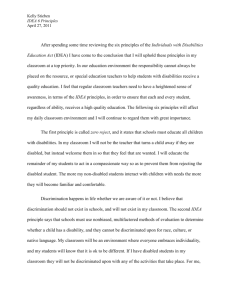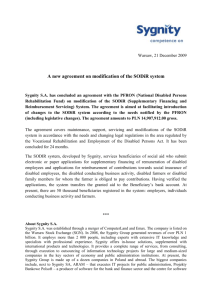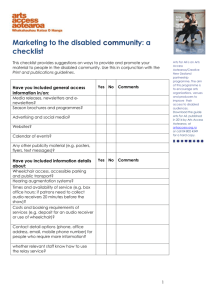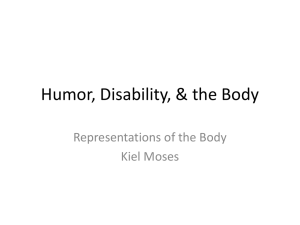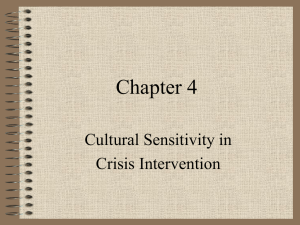Barriers faced by disabled people
advertisement
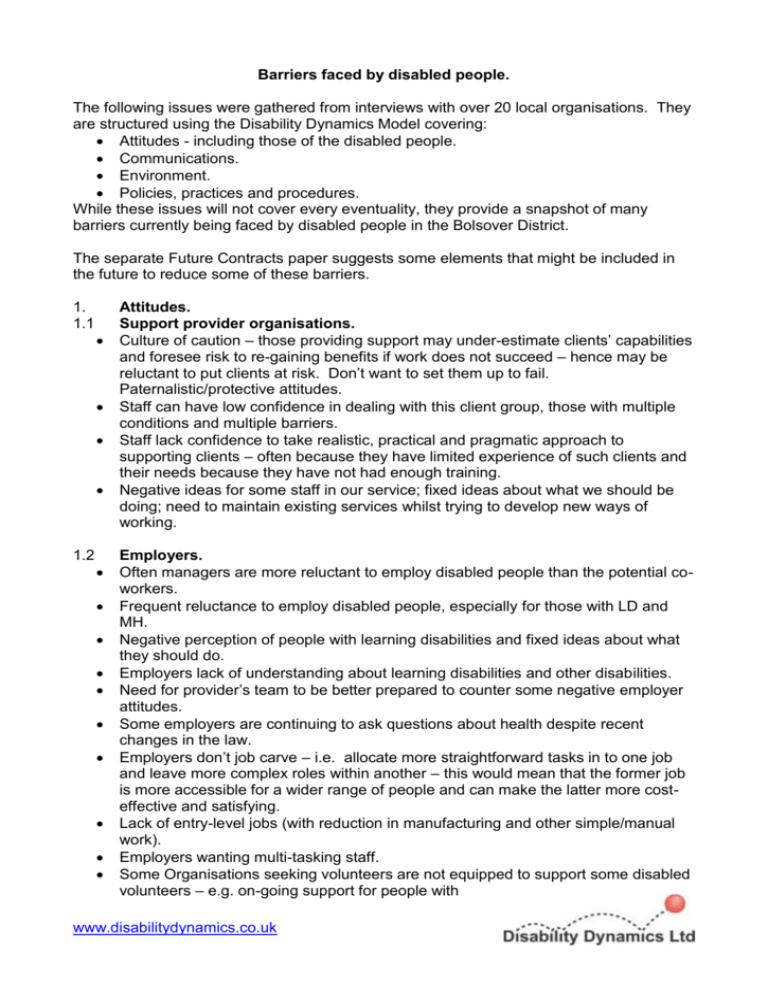
Barriers faced by disabled people. The following issues were gathered from interviews with over 20 local organisations. They are structured using the Disability Dynamics Model covering: Attitudes - including those of the disabled people. Communications. Environment. Policies, practices and procedures. While these issues will not cover every eventuality, they provide a snapshot of many barriers currently being faced by disabled people in the Bolsover District. The separate Future Contracts paper suggests some elements that might be included in the future to reduce some of these barriers. 1. 1.1 1.2 Attitudes. Support provider organisations. Culture of caution – those providing support may under-estimate clients’ capabilities and foresee risk to re-gaining benefits if work does not succeed – hence may be reluctant to put clients at risk. Don’t want to set them up to fail. Paternalistic/protective attitudes. Staff can have low confidence in dealing with this client group, those with multiple conditions and multiple barriers. Staff lack confidence to take realistic, practical and pragmatic approach to supporting clients – often because they have limited experience of such clients and their needs because they have not had enough training. Negative ideas for some staff in our service; fixed ideas about what we should be doing; need to maintain existing services whilst trying to develop new ways of working. Employers. Often managers are more reluctant to employ disabled people than the potential coworkers. Frequent reluctance to employ disabled people, especially for those with LD and MH. Negative perception of people with learning disabilities and fixed ideas about what they should do. Employers lack of understanding about learning disabilities and other disabilities. Need for provider’s team to be better prepared to counter some negative employer attitudes. Some employers are continuing to ask questions about health despite recent changes in the law. Employers don’t job carve – i.e. allocate more straightforward tasks in to one job and leave more complex roles within another – this would mean that the former job is more accessible for a wider range of people and can make the latter more costeffective and satisfying. Lack of entry-level jobs (with reduction in manufacturing and other simple/manual work). Employers wanting multi-tasking staff. Some Organisations seeking volunteers are not equipped to support some disabled volunteers – e.g. on-going support for people with www.disabilitydynamics.co.uk learning difficulties who may need to have tasks repeated for them. Providers arranging volunteering opportunities need to check that receiving organisations fulfil their legal duties, do not discriminate and make reasonable adjustment - if not; such receiving organisations should no longer be supported. 1.3 1.4 Family and friends. Family influence – over-protective. Difficult to get clients with learning disabilities accepted in to society. Disabled clients. Social isolation and the consequent mental health conditions. Can be nervous, will not talk to others, apathetic. Let down in the past so sceptical about future/help. May not perceive that support is open to them – e.g. Access to BL services – may perceive that it is not for them – perceive that BL is about business and not selfemployment. Main psychological changes needed are: o Feel that could achieve work – having the confidence to se that it is a possibility. o Feeling that they have the capacity to do work – confidence in their own capability to do a job. Overcoming inertia – where it is safer to remain in existing “comfort zone” rather than face the challenges of the job application process/moving off benefits (they perceive the difficulties of re-gaining benefits as a major reason for not risking going back to work). Fear of the unknown, risk to benefits and consequences if job/business does not succeed. Young mums stuck at home but keen to get out and talk to adults. 2. Communications. 2.1 Recruitment. Many providers use leaflets, posters etc to recruit their clients but several were less confident about whether they were using accessible information/communications in relation to format/content. Some providers recognised that they need to amend literature to use words such as “accessible” and “inclusive” to demonstrate that their services are open to disabled people. Jobcentre Plus has a significant role in recruitment/making referrals so it is essential that those Advisers have quick and easy access to the range of support available. It would be worth confirming whether this is the case. Not all providers have links with/gain referrals via disability organisations – although it is recognised that many disabled people also do not have links with such. It may be worthwhile ensuring that such organisations are aware of the support available. Some providers are making cross-referrals with other support organisations but there appears to be scope for more. 2.3 Reasonable adjustments. While most “disability-specialist” providers are comprehensive in the reasonable adjustments they offer (accessible information and communications, adaptive IT equipment, support workers etc), the mainstream providers were less confident/prepared. www.disabilitydynamics.co.uk 2.2 3. 3.1 3.2 Training. Similar issues around accessible information/communications may arise in relation to training – how it is delivered and any materials. Environment. Travel and transport. General issues: o Many disabled people are not able to travel independently, especially those with LD. o Clients not confident enough to use public transport. Some are fearful of using public transport late at night. o Clients cannot read bus timetables or other information for buses and trains. o Clients reluctant to travel outside local areas. Travel costs: o Clients cannot afford travel and many organisations struggle to provide help with travel costs. Public transport: o Lack of public transport and high costs in this rural area. Particularly for those with MH conditions as they are no longer eligible free bus passes. o Public transport can be inaccessible for some disabled people: visually impaired people may not be able to get to bus stops etc whereas some (with mental health conditions or learning disabilities) can be too anxious to use such transport unaccompanied. Hence Higher reliance on taxis, which are expensive for people dependent on benefits. o First buses are too late for people to attend courses. o Bus times do not fit in with courses or work start/end times. Increasing amount of shift work in the area. o Bus passes do not start until after 0930. So may have to take people with learning difficulties to locations using day centre buses which defeats the possibility of them becoming more independent. E.G for volunteering opportunities at Hardwick House, clients would have to get bus in to Chesterfield and then out to Home Wood and then walk about 3-4 miles. o Using public transport can build individuals’ confidence and independence. Taxis: o It seems that some taxi companies providing accessible vehicles increase the cost to the customer by starting the meter before the customer is on board – and it can take longer to board when ramps etc are required. They tend to use the taxi firms that charge fairly but this means that fewer accessible taxis are available. Reasonable adjustments. Most providers consider that they offer accessible venues where such are used. Many providers offer help with transport/travel costs. Policies, practices and procedures. Equality and diversity policies. Most providers did not know if their equality and diversity policies covered disabled clients/service users and reasonable adjustments for them. 4. 4.1 www.disabilitydynamics.co.uk 4.2 Delivery policies, practices and procedures. Many (but not all) providers recognise that disabled clients can have very complex needs. It was not always apparent that this is translated in to inclusive delivery policies, practices and procedures that will accommodate these needs. This would also require that resources (funding, staff time, provision for reasonable adjustments etc) and staff training are also in place to implement the more inclusive policies, practices and procedures. Personal issues: o low confidence. o limited communication skills. o family and other care commitments – may need Provision of child care/crèches. o personal appearance/hygiene. Work/training/volunteering issues: o Need help with interview techniques, completing application forms, o Need help with job search skills/techniques. o Limited work history o Lack of work skills and experience. o Lack of work opportunities especially in rural areas. o inability to travel independently o Low literacy/numeracy. o criminal record. o CRB checks for clients if they are going to volunteering, work in childcare and in NHS etc – they cannot afford and takes a long time. Disability-related issues: o Need to manage Health conditions, particularly mental health. o Need for specialist help for people with visual impairments and mental health conditions to access vocational training. o Need for support workers for those with mental health conditions – they may need someone to support them when undertaking new activities. o some have complex language problems perhaps BSL and a foreign language. o Spikey progress. Some clients have fluctuating/recurring health problems and others acquire new health conditions. Both can mean that their participation is not consistent – this presents planning problems as it is not possible to always rely on volunteers and delivery programmes need to be very flexible - and accept that some of these clients can take longer to progress. o Timescales – extra help needs may mean that disabled people miss the first course or that their support is delayed. o May be institutionalised by time in day centres. o Work Choice clients are those furthest from employment, often with complex and multiple barriers in addition to any disability or long-term health condition. Foundation level issues: o Debt. o Housing. 4.3 Funding policy. To be effective with this client group, funding/contract policies need to recognise that: Short term funding may defeat the outcomes. Resources are needed for on-going support of clients even once in work – to manage changes of circumstances, health conditions, issues with employer, benefits and WTC systems. www.disabilitydynamics.co.uk Clients can require longer term and repeated support as their progression can be spikey. Help with clients’ work/training travel is likely to be required but cannot count as outcome until they get training/job offer. – So interview may not count. See also the delivery requirements (4.2) and eligibility issues (4.4). 4.4 Eligibility policies. Providers need to make eligibility for their services as inclusive as possible and seek to avoid the following situations: Apprenticeship Scheme usually requires at least Level 2 qualifications which tends to exclude those with LD (and other disabilities). Funding that is driven by outcomes can force providers to assess capabilities at the outset – this will exclude some disabled people as providers cannot afford to take the risk that they do not achieve the outcome. Government support such as Work Choice is funded by outcomes which are over 16 hours work per week but this may not be possible for many clients, especially those with LD - and so they may be excluded from the support. © www.disabilitydynamics.co.uk


